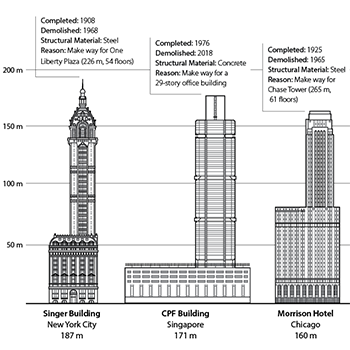Filter by
You must be a CTBUH Member to view this resource.
JPMorgan Chase Tower
Union Carbide Building, Chase World Headquarters
Building
Demolished
10017
office
steel
LEED Platinum BD+C: New Construction
215.5 m / 707 ft
52
24
223,000 m² / 2,400,352 ft²
Construction Start
Completed
Retrofit Start
Retrofit End
Demolished
Usually involved in the front end design, with a "typical" condition being that of a leadership role through either Schematic Design or Design Development, and then a monitoring role through the CD and CA phases.
Usually involved in the front end design, with a "typical" condition being that of a leadership role through either Schematic Design or Design Development, and then a monitoring role through the CD and CA phases.
Other Consultant refers to other organizations which provided significant consultation services for a building project (e.g. wind consultants, environmental consultants, fire and life safety consultants, etc).
You must be a CTBUH Member to view this resource.
Usually involved in the front end design, with a "typical" condition being that of a leadership role through either Schematic Design or Design Development, and then a monitoring role through the CD and CA phases.
The Design Engineer is usually involved in the front end design, typically taking the leadership role in the Schematic Design and Design Development, and then a monitoring role through the CD and CA phases.
The main contractor is the supervisory contractor of all construction work on a project, management of sub-contractors and vendors, etc. May be referred to as "Construction Manager," however, for consistency CTBUH uses the term "Main Contractor" exclusively.
Other Consultant refers to other organizations which provided significant consultation services for a building project (e.g. wind consultants, environmental consultants, fire and life safety consultants, etc).
Usually involved in the front end design, with a "typical" condition being that of a leadership role through either Schematic Design or Design Development, and then a monitoring role through the CD and CA phases.
The Design Engineer is usually involved in the front end design, typically taking the leadership role in the Schematic Design and Design Development, and then a monitoring role through the CD and CA phases.
Other Consultant refers to other organizations which provided significant consultation services for a building project (e.g. wind consultants, environmental consultants, fire and life safety consultants, etc).
2019 Tall Building Predictions for the Year to Come
22 January 2019 - CTBUH News
Building Tall Lecture Addresses Skyscraper Renovations
29 November 2018 - Event

27 April 2018
World's Tallest Demolished Buildings
CTBUH Research
Although the world has more than 1,300 buildings of 200 meters or higher, no tall building of more than 187 meters has been demolished, with...
22 January 2019
Check out our monthly predictions based on our industry intelligence to see what trends and milestones will shape the industry in the year to come!
Subscribe below to receive periodic updates from CTBUH on the latest Tall Building and Urban news and CTBUH initiatives, including our monthly newsletter. Fields with a red asterisk (*) next to them are required.
View our privacy policy